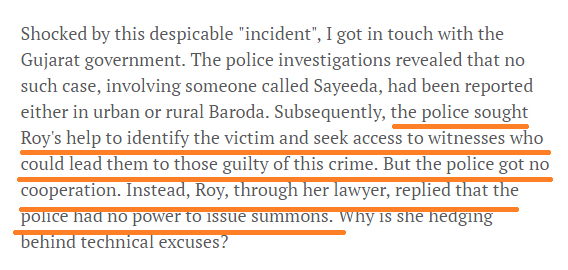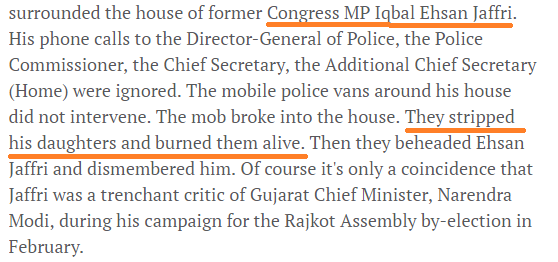Arundhati Roy is a very lucky person. Right before her book release, it just so happens that somebody starts planting fake news stories about her, putting Ms. Roy at the heart of controversy. Everybody knows there is no such thing as bad publicity.
The episode put ‘fake news’ in focus again with hilarious results. The mainstream media, which is the leading manufacturer of fake news, decided to hold debates and shows on ‘fake news’. Or maybe they are right, after all they have the expertise.
But not just the mainstream media, even Arundhati Roy seems to have the expertise. I’ll illustrate this by telling you how Arundhati Roy creates fake news, sustains it, and how she actually uses it to further advantage even when caught.
You kids take notes. Watch and learn from the legend herself.
(1) It happened to a friend of a friend…
The year was 2002. A fiery Arundhati Roy was determined to shake the conscience of the nation like she always does. Here she is, writing in the Outlook:

Shocking beyond words, no?
Soon after, Balbir Punj (then a BJP MP) decided to follow up on this horrific incident to try and get justice for Sayeeda. Only to find out this:

Not only was Sayeeda brutally murdered, the friends of her friends didn’t even want to help with identifying her or her killers.
Key takeaways:
a. Never take direct responsibility for a claim. Always refer to a “friend from Baroda”.
b. When pressed for details, exercise your legal right to remain silent.
(2) Use the fact that foreign audiences don’t know a lot about India
Are you facing a foreign audience that knows little about our internal political affairs? Excellent! Here is your chance to retell India’s history any way you want by moving events around freely in all dimensions of time and space. There’s no fear of getting caught.
So here is Arundhati Roy unplugged at Northwestern Law School in Chicago (see here for full speech)
She goes: “A train full of pilgrims coming back from the destruction of this Ayodhya mosque which was disputed. The train caught fire; nobody knows who set fire to the train…”
Yes, why not slide the Babri demolition along the time dimension from 1992 to 2002 so that the karsevaks who died in Godhra can be accused of destroying it? The American audience probably won’t realize this. So, lie away…
Not to mention that she shoved in another lie into that quote. Nobody knows who set fire to the train? Really? A court of law has actually sentenced the accused, many of them to death.
But then, liberal media is such that I suspect most Indians don’t know about the conviction of the perpetrators of Godhra. This is likely because the sentencing in the Godhra carnage was not followed by screaming headlines of “Justice for Godhra victims“. How would Americans know?
Key takeaways:
a. Assume your audience to be ignorant, or choose an ignorant audience to propagate fake news.
b. Throw in a smaller lie along with a big lie so that people focus on the bigger lie and the smaller lie is assumed to be the truth.
(3) Genuine Errors do not alter the substance of what is being said
In the same Outlook article that I mentioned above, Arundhati Roy speaks thus on the Gulberg Society case.

Stripped his daughters and burned them alive? It turns out that Ehsan Jaffri had only one daughter (not daughters) and that she is very much alive. In fact, she was actually in the US (and thank god that she is safe and sound) on the day this attack happened. As Ehsan Jaffri’s son pointed out in an interview to The Asian Age on May 2:
“Among my brothers and sisters, I am the only one living in India. And I am the eldest in the family. My sister and brother live in the US. I am 40 years old.”
This time Arundhati Roy had broken her own standard operating procedure and forgotten to blame a “friend from Baroda”. And so it happened that she actually had to publish an apology, in which her justification achieves the gold standard of hypocrisy:
“In a situation like the one that prevails in Gujarat, when the police are reluctant to register firs, when the administration is openly hostile to those trying to gather facts, and when the killings go on unabated—then panic, fear and rumour play a pivotal role. People who have disappeared are presumed dead, people who have been dismembered and burnt cannot be identified, and people who are distraught and traumatised are incoherent…. This and other genuine errors in recounting the details of the violence in Gujarat in no way alters the substance of what journalists, fact-finding missions, or writers like myself are saying.”
Did you catch that? When you are caught peddling fake news, don’t retreat. Instead blame the other side for creating a situation which led you to fall for the rumors! So what if rumors are playing a “pivotal role” in Arundhati Roy’s reporting? It is actually the fault of the Gujarat government that Arundhati Roy did not check her facts. And then there is the amazing assertion that “genuine errors in recounting details” in no way alter the substance of what is being said!
The errors in recounting details (i.e. the facts) don’t matter. Only the substance of what is being said (i.e. the narrative) matters. Mahaul over data, as was recently argued to claim ‘rising intolerance’.
Key takeaways:
a. Facts are not sacrosanct if you can write in a flowery language. Invent facts and pray you are not caught.
b. If you are caught, go back to your flowery language and invent circumstances that leads to justifiable invention of facts.
Has anyone ever expressed the motto of fake news so crisply and clearly?
You kids take notes. Learn from Arundhati Roy how fake news is done right.



